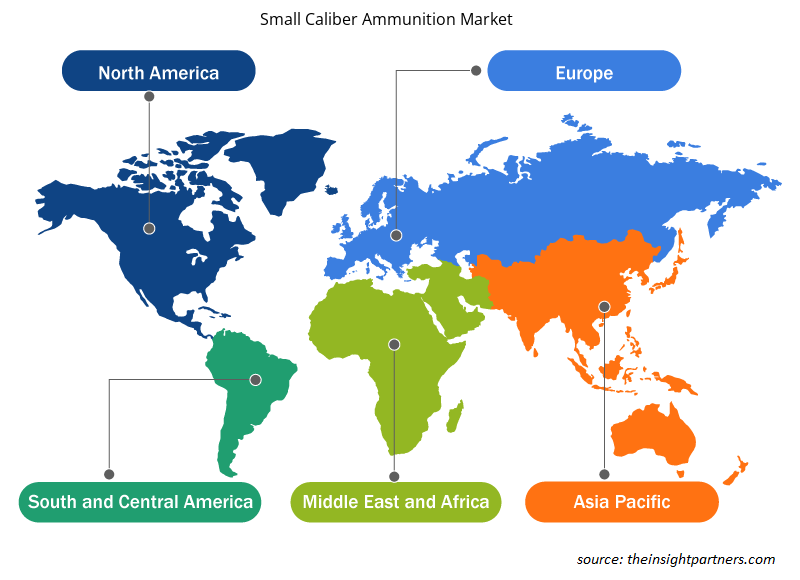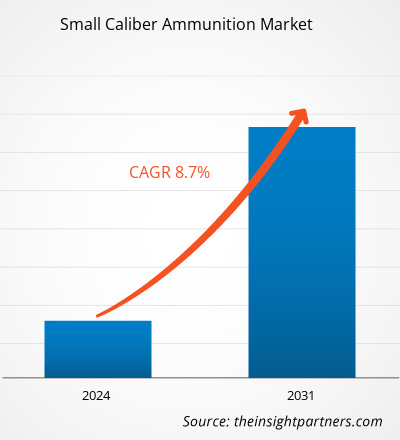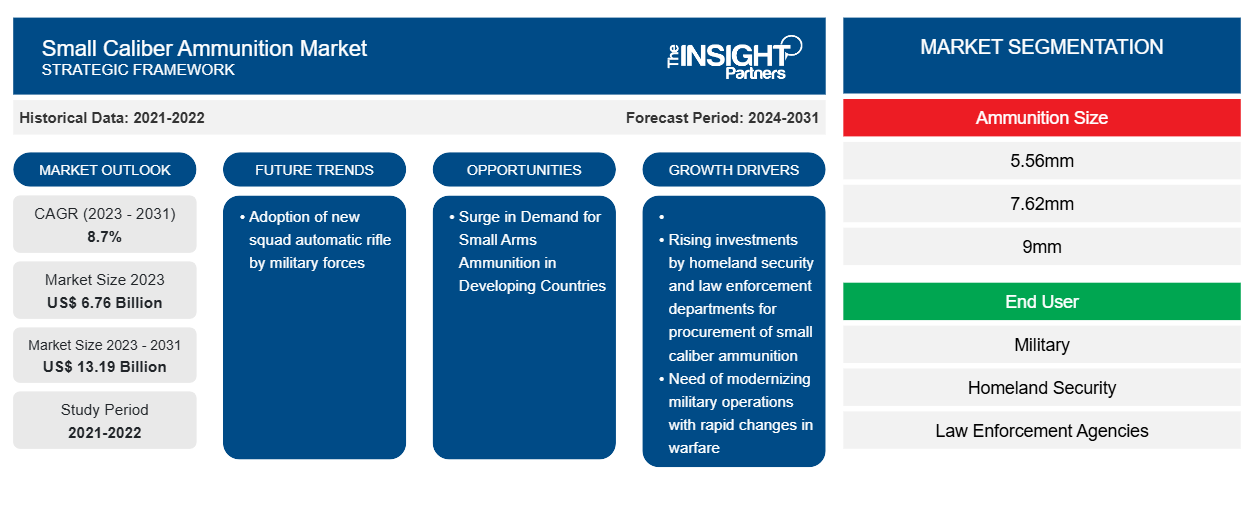小口径弹药市场规模预计将从 2023 年的 67.6 亿美元增至 2031 年的 131.9 亿美元。预计 2023-2031 年期间市场复合年增长率将达到8.7%。军队采用新型班用自动步枪可能仍是市场的主要趋势。
小口径弹药市场分析
小口径弹药市场的关键参与者包括通用动力军械和战术系统公司、泰雷兹集团、诺斯罗普·格鲁曼公司、英国航宇系统公司和 Vista Outdoor。排名根据产品组合、年度分部收入、品牌形象和合同等参数进行分析。这些公司正积极参与不同类型小口径弹药的持续开发。此外,这些参与者在各自的研发团队中投入大量资金,设计和开发满足军事、国土安全、执法和武器制造商需求的小口径弹药。因此,图中提到的参与者是全球武器制造商和最终用户中的关键承包商,帮助他们通过小口径弹药逐年创造更高的收入。
小口径弹药市场概况
小口径弹药市场的主要利益相关者包括原材料供应商、小口径弹药制造商和最终用户。生产小口径弹药所用的原材料包括化学能量物质(硝化纤维素和黑色火药成分)、金属和炮弹。大量原材料供应商的存在使得小口径弹药市场参与者能够选择合适的供应商。这增强了小口径弹药行业的供应链。在采购原材料后,小口径弹药市场参与者会生产大量不同口径的小口径弹药,从而满足各个客户的需求。小口径弹药市场的最终用户包括执法机构和军队。
定制此报告以满足您的需求
您可以免费定制任何报告,包括本报告的部分内容、国家级分析、Excel 数据包,以及为初创企业和大学提供优惠和折扣
-
获取此报告的关键市场趋势。这个免费样品将包括数据分析,从市场趋势到估计和预测。
小口径弹药市场驱动因素和机遇
战争快速变化下军事行动现代化的必要性
现代战争的快速变化促使各国政府向各自的军队分配更多资金。由于现有的 5.56 毫米等口径在穿透更坚固的装甲方面变得无效,军队正专注于 7.62 毫米等口径以获得更大的射程。军事预算分配使军队能够致力于开发强大的本土技术,同时从国内外制造商采购先进的武器、弹药、车辆和其他设备。此外,士兵和军车的现代化实践有助于他们让人员和车辆随时准备执行任务。增加的军事投资正用于采购新技术,包括不同类型的弹药,这正在推动小口径弹药市场的增长。
发展中国家对小型武器弹药的需求激增
各个发达国家和发展中国家之间恐怖袭击事件的增多和政治不稳定促使国防和国土安全部队增加对先进解决方案的采购,例如雷达系统、通信系统和反无人机技术等。例如,美国国防部、欧盟和印度国防部等其他机构多年来增加了对反无人机采购的支出。这导致小口径弹药制造商采用有机和无机增长战略,例如高投资、产品供应和全球扩张,进一步为全球小口径弹药市场创造增长机会。
小口径弹药市场报告细分分析
有助于得出小口径弹药市场分析的关键部分是弹药尺寸、最终用户和枪支类型。
- 根据弹药尺寸,小口径弹药市场细分为 5.56 毫米、7.62 毫米、9 毫米、12.7 毫米、14.5 毫米、45ACP、.338 毫米、.22LR、223 REM、.308 温彻斯特和其他。9 毫米部分在 2023 年占据了更大的市场份额。
- 根据最终用户,小口径弹药市场分为军事、国土安全和执法机构。军事部门在 2023 年占据了更大的市场份额。
- 根据枪支类型,小口径弹药市场分为手枪、步枪和霰弹枪。2023 年,手枪占据了较大的市场份额。
小口径弹药市场份额按地区分析
小口径弹药市场报告的地理范围主要分为五个地区:北美、欧洲、亚太、中东和非洲、南美。
2023 年,北美占据了市场主导地位,其次是欧洲和亚太地区。此外,亚太地区在未来几年也可能出现最高的复合年增长率。美国在北美小口径弹药市场占有主要份额。美国是世界上最大的军费支出国,拥有最大的军队规模,由于其在美国境内和其他国家/地区的广泛行动,在弹药采购上投入了大量资金。这导致该国对弹药的需求不断增长。此外,该国军队作为北约部队的一部分部署在各个外国地点执行维和行动,这进一步增加了需求的增长。此外,美国陆军参与了伊拉克和阿富汗等行动,并拥有十多家制造弹药、弹药组件和其他军械材料(如枪管和枪架)的工厂,自过去十年以来,弹药支出有所增加。此外,美国陆军计划采用 6.8 毫米武器,并已选择 General Dynamics-OTS Inc.、AAI Corporation Textron Systems 和 Sig Sauer Inc. 来交付下一代班组武器 (NGSW) 的自动步枪和步枪版本的原型以及数十万发特殊 6.8 毫米弹药。此外,美国陆军于 2019 年与 Alliant Techsystems Operations LLC 签订了一份价值 1.94 亿美元的长期重大合同,以在未来十年内供应小口径弹药并对其 Lake City 陆军弹药厂进行现代化改造和运营,从而推动了市场增长。
小口径弹药市场区域洞察
Insight Partners 的分析师已详细解释了预测期内影响小口径弹药市场的区域趋势和因素。本节还讨论了北美、欧洲、亚太地区、中东和非洲以及南美和中美洲的小口径弹药市场细分和地理位置。

- 获取小口径弹药市场的区域特定数据
小口径弹药市场报告范围
| 报告属性 | 细节 |
|---|---|
| 2023 年的市场规模 | 67.6亿美元 |
| 2031 年市场规模 | 131.9亿美元 |
| 全球复合年增长率(2023 - 2031) | 8.7% |
| 史料 | 2021-2022 |
| 预测期 | 2024-2031 |
| 涵盖的领域 |
按弹药尺寸
|
| 覆盖地区和国家 |
北美
|
| 市场领导者和主要公司简介 |
|
市场参与者密度:了解其对商业动态的影响
小口径弹药市场正在快速增长,这得益于终端用户需求的不断增长,这些需求源于消费者偏好的不断变化、技术进步以及对产品优势的认识不断提高等因素。随着需求的增加,企业正在扩大其产品范围,进行创新以满足消费者的需求,并利用新兴趋势,从而进一步推动市场增长。
市场参与者密度是指在特定市场或行业内运营的企业或公司的分布情况。它表明在给定市场空间中,相对于其规模或总市场价值,有多少竞争对手(市场参与者)存在。
在小口径弹药市场运营的主要公司有:
- BAE系统公司
- CBC 全球弹药
- 丹尼尔比勒陀利亚金属压制公司
- 埃尔比特系统有限公司
- FN赫斯特尔
- 通用动力OTS
免责声明:上面列出的公司没有按照任何特定顺序排列。

- 了解小口径弹药市场顶级关键参与者概况
小口径弹药市场新闻和最新发展
小口径弹药市场通过收集一手和二手研究后的定性和定量数据进行评估,其中包括重要的公司出版物、协会数据和数据库。小口径弹药市场的一些发展情况如下:
- Colt CZ Group SE(“Colt CZ”、“集团”或“公司”)特此宣布,其于 2023 年 12 月 18 日与 CBC Europe S.à rl(“CBC”)签署协议,以收购 Sellier & Bellot 的 100% 股权(“Sellier & Bellot”)。(来源:Colt CZ Group SE,新闻稿,2023 年 12 月)
- 捷克斯洛伐克集团 (CSG) 收购了 Fiocchi Munizioni 70% 的股份,Fiocchi Munizioni 是高端和超高端小口径弹药领域的全球领导者,CSG 将与其他利益相关者合作,继续为 Fiocchi Munizioni 规划增长道路。(来源:捷克斯洛伐克集团,新闻稿,2022 年 11 月)
小口径弹药市场报告覆盖范围和交付成果
“小口径弹药市场规模和预测(2021-2031 年)”报告对以下领域进行了详细的市场分析:
- 范围内涵盖的所有主要细分市场的小口径弹药市场规模和全球、区域和国家层面的预测
- 小口径弹药市场趋势以及市场动态,如驱动因素、限制因素和关键机遇
- 详细的波特五力分析
- 小口径弹药市场分析涵盖主要市场趋势、全球和区域框架、主要参与者、法规和最新市场发展
- 行业格局和竞争分析,涵盖市场集中度、热点图分析、知名参与者以及小口径弹药市场的最新发展
- 详细的公司简介
- 历史分析(2 年)、基准年、预测(7 年)及复合年增长率
- PEST和SWOT分析
- 市场规模、价值/数量 - 全球、区域、国家
- 行业和竞争格局
- Excel 数据集
近期报告
客户评价
购买理由
- 明智的决策
- 了解市场动态
- 竞争分析
- 客户洞察
- 市场预测
- 风险规避
- 战略规划
- 投资论证
- 识别新兴市场
- 优化营销策略
- 提升运营效率
- 顺应监管趋势























 获取免费样品 - 小口径弹药市场
获取免费样品 - 小口径弹药市场